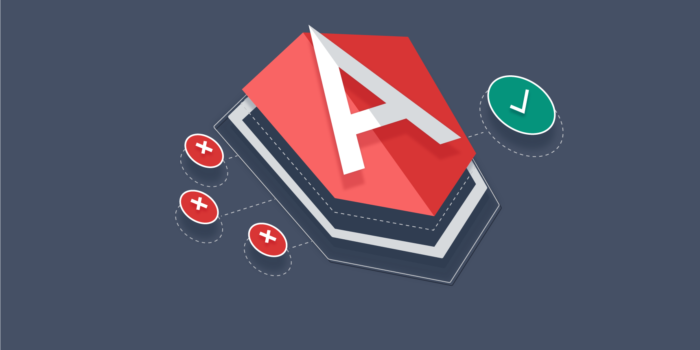This Introduction to Angular Tutorial gives you a glimpse of Angular. Angular is a UI framework for building mobile and desktop web applications. It is built using Javascript. Using Angular you can build amazing client-side applications using HTML, CSS, and Typescript. It is very important to know how the Angular framework works before you start using it. The following tutorials introduce you to Angular and discuss Angulars architecture.
- Introduction to Angular
- Angular Architecture Overview & Concepts
Getting Started With Angular Tutorial
The Angular has gone through a lot of changes since the version Angular 2. From the Angular 7 version, installing and creating a new project in angular has become very simple. The only thing you need to do in install and Visual Studio code, NPM Package manager & Angular CLI. Once, you install the required dependencies, creating a new project is as easy as running a simple command ng new. Angular CLI takes care of Configuration & initialization of various libraries.
The following step by step tutorial will take you through the process of creating an Angular application
- Installing and Setting Up an Angular Development Environment
- How to Create a new project in Angular
- Bootstrapping in Angular
Components
The Component is the main building block of an Angular Application. A Component contains the definition of the View and the data that defines how the View looks and behaves. The Angular Components are plain javascript classes and defined using @component Decorator. This Decorator provides the component with the View to display & Metadata about the class
The Component passes the data to the view using a process called Data Binding. This is done by Binding the DOM Elements to component properties. Binding can be used to display component class property values to the user, change element styles, respond to a user event, etc.
- Introduction to Angular Components
- Data Binding in Angular
- Interpolation in Angular
- Property Binding in Angular
- Event Binding in Angular
- Two way Binding & ngModel in Angular
- ngModelChange & Change Event
- Adding Child Component in Angular
Directives
The Angular directive helps us to manipulate the DOM. You can change the appearance, behavior, or layout of a DOM element using the directives. They help you to extend HTML. The Angular directives are classified into three categories based on how they behave. They are Component, Structural and Attribute Directives
The ngFor is an Angular structural directive, which repeats a portion of the HTML template once per each item from an iterable list (Collection). The ngSwitch allows us to Add/Remove DOM Element. It is similar to the switch statement of Javascript. The ngIf allows us to Add/Remove DOM Element.
The ngClass Directive is an Angular Attribute Directive, which allows us to add or remove CSS classes to an HTML element. The ngStyle directive allows you to modify the style of an HTML element using the expression. Using the ngStyle you can dynamically change the style of your HTML element.
Pipes
The Angular pipes are used to Transform the Data. For Example, the Date pipe formats the date according to locale rules. We can pass arguments to pipe and chain pipes. The Angular also allows us to create the Custom Pipe
- Angular Pipes
- Angular Custom Pipes
- Date Pipe
- Async Pipe
- KeyValue Pipe
- Using Pipes in Components & Services
Component Communication
- Angular Component Communication
- Passing data from Parent to child component
- Passing Data from Child to Parent Component
Component Life Cycle Hook
The life cycle hooks are the methods that angular invokes on directives and components as it creates, changes, and destroys them. Using life-cycle hooks we can fine-tune the behavior of our components during creation, update, and destruction.
Angular Forms
The data entry forms can be very simple to very complex. The Forms contain large no of input fields, a variety of fields like Text boxes, Dates, Numbers, Emails, Password, Check Boxes, Option boxes, etc. These fields can Span multiple tabs or multiple pages. Forms may also contain complex validation logic interdependent on multiple fields.
The Angular forms modules are designed to handle all of the above and a lot more. The Angular Forms now supports Reactive forms approach to Forms development. The older way of Template-based approach is also supported
- Angular Forms Tutorial: Fundamental & Concepts
- Template Driven Forms in Angular
- Set Value in Template Driven forms in Angular
- Reactive Forms in Angular
- FormBuilder in Reactive Forms
- SetValue & PatchValue in Angular
- StatusChanges in Angular Forms
- ValueChanges in Angular Forms
- FormControl
- FormGroup
- FormArray Example
- Build Dynamic or Nested Forms using FormArray
- SetValue & PatchValue in FormArray
- Select Options Dropdown
Services & Dependency Injection
Services allow us to create reusable code and use it every component that needs it. The Services can be injected into components and other services using the dependency injection system. The dependencies are declared in the Module using the Provider’s metadata. The Angular creates a tree of injector & Providers that resembles the Component Tree. This is called the hierarchical pattern.
- Services
- Dependency injection
- Injector, @Injectable & @Inject
- Providers
- Injection Token
- Hierarchical Dependency Injection
- Angular Singleton Service
- ProvidedIn root, any & platform
- @Self, @SkipSelf & @Optional Decorators
- @Host Decorator in Angular
- ViewProviders
Angular Forms Validation
One of the common tasks that is performed, while building a form is Validation. The Forms Validation is built into the Angular Forms Module. The Angular provides several Built-in validators out of the box. If those validators do not fit your needs, then you can create your own custom validator.
- Validations in Reactive Forms in Angular
- Custom Validator in Reactive Forms
- Passing Parameter to Custom Validator in Reactive Forms
- Inject Service into Custom Validator
- Validation in Template Driven Forms
- Custom Validator in Template Driven Forms
- Angular Async Validator
- Cross Field Validation
- Adding Validators Using SetValidators
HTTP
The newly designed HttpClient Module allows us to query the Remote API source to get data into our Application. It requires us to Subscribe to the returned response using RxJs observables.
- Angular HTTP Client Tutorial
- HTTP GET Example
- HTTP POST Example
- Passing URL Parameters (Query strings)
- HTTP Headers Example
- HTTP Interceptor
Angular Router
The Router module handles the navigation & Routing in Angular. The Routing allows you to move from one part of the application to another part or one View to another View.
- Routing and Navigation in Angular
- Location Strategies in Angular Router
- Passing Parameters to Route
- Child Routes / Nested Routes
- Passing Optional (Query) Parameters to a route
- Navigation between Routes
- Angular Route Guards
- CanActivate Guard
- CanActivateChild Guard
- CanDeactivate Guard
- Angular Resolve Guard
- Angular Pass data to route
- RouterLinkActive
- Router Events
Angular Module
The Angular Modules help us to organize our code into manageable parts or block. Each block implements a specific feature. The Components, Templates, Directives, Pipes, and Services, which implements that feature become part of the module. The following tutorial explains, how best you can create an Angular Module, The folder structure that you can use, etc. We can also load the Modules lazily or Preload thus improving the performance of the Application.
- Introduction to Angular Modules
- Routing Between Angular Modules
- Angular folder structure: Best Practices
- Lazy Loading in Angular
- Preloading Strategy
- CanLoad Guard
Advanced Components
The Components in Angular are very powerful feature. The following tutorials take you through some of the important features of the Angular Component.
- Ng-Content & Content Projection in Angular
- Angular @input, @output & EventEmitter
- Template Reference Variable in Angular
- ng-container in Angular
- ng-template & TemplateRef in angular
- ngtemplateoutlet in angular
- HostBinding & HostListener
- ViewChild, ViewChildren & QueryList
- ElementRef
- Renderer2
- ContentChild & ContentChildren
- AfterViewInit, AfterViewChecked, AfterContentInit & AfterContentChecked
- Angular Decorators
Observable in Angular
The Angular uses the Observable Pattern extensively. The following tutorials gives you an introduction to observable and how to use it in an Angular Application.
- Angular Observable Tutorial
- Create Observable from a string, array. object, collection
- Observable from events using fromEvent
- Observable pipe
- Map Operator
- Filter Operator
- Tap Operator
- SwitchMap
- MergeMap
- ConcatMap
- ExhaustMap
- take, takeUntil, takeWhile, takeLast
- First, last & Single
- Skip, SkipWhile, SkipUntil & SkipLast
- Scan & Reduce
- DebounceTime & Debounce
- Delay & DelayWhen
- ThrowError
- CatchError
- ReTry & ReTryWhen
- Unsubscribe from an observable
- Subjects in Angular
- ReplaySubject, BehaviorSubject & AsyncSubject
- Angular Subject Example
Styling the Application
The Angular uses several different ways to style the Application. You can style the app globally and then override it locally in the component very easily. The component styles have local scope, which is achieved using the various View Encapsulation strategies. Learn all these in the section
- Angular Global Styles
- View Encapsulation
- Style binding in Angular
- Class Binding in Angular
- Component Styles
- How to Install & Use Angular FontAwesome
- How to Add Bootstrap to Angular
Others
Configuration
The apps usually need some sort of Run-time configuration information like URL endpoint etc, which it needs to load at startup. Also, different environments like development, production & testing require different environments, etc.
Handling Errors
In the following Angular tutorials, we look at how Angular handles the error. We handle errors by setting up a Global Error handler or custom error handler. Also,.whenever the error occurs in an HTTP operation, the Angular wraps it in an httpErrorResponse Object. Learn how to handle the HTTP Errors also.
Angular CLI
Learn how to use Angular CLI to speed up the development of Angular Application
SEO & Angular
You Website is useless if it is not found by the Search Engines. There are many things you must consider to make App SEO friendly. You need to set up Title & Meta Tags for each page. Ensure that the search engines can crawl and read your page. Set the correct Canonical URL for each page etc. Also, ensure that the app loads quickly, etc. The Following Angular Tutorials guides you through some of the important SEO features.
- Title Service Example
- Dynamic Title based on Route
- Meta Service
- Dynamic Meta Tags
- Canonical URL
- Lazy Load Images in Angular
Angular Universal
The following Angular Universal Tutorial explains how to achieve Server Side Rendering using Angular Universal. The rendering the App on the server side makes it load quickly and also ensures that the search engines can crawl the content
Building & Hosting
Angular Resources
Angular how-to guides
- How to get the current Route
- ExpressionChangedAfterItHasBeenCheckedError in Angular
- Angular CLI Check Version
- Property ‘value’ does not exist on type ‘EventTarget’ Error in Angular

